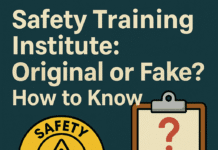
OH&S Certificate: Ensuring Workplace Safety
OH&S Certificate : In today’s fast-paced and ever-evolving world, workplace safety is a top priority for both employers and employees. Occupational Health and Safety (OH&S) measures play a crucial role in safeguarding individuals at work. In this article, we’ll explore the importance of OH&S certificates, what they entail, and why they are vital for a secure and productive work environment.
1. Introduction to OH&S
Occupational Health and Safety (OH&S) is a multidisciplinary field that focuses on identifying and mitigating workplace hazards to ensure the well-being of employees. It encompasses various aspects of safety, including the physical, mental, and emotional health of workers.
2. What Is an OH&S Certificate?
An OH&S certificate is a formal recognition of an individual’s expertise in occupational health and safety. It signifies that the certificate holder has undergone training and demonstrated proficiency in implementing safety measures within a workplace.
3. Benefits of Obtaining an OH&S Certificate
3.1 Enhanced Employability
Employers value candidates with OH&S certificates as they are equipped to create safer work environments, reducing the risk of accidents.
3.2 Improved Workplace Safety
OH&S certificate holders possess the knowledge and skills to identify and rectify potential hazards, ensuring a secure workplace for all.
3.3 Legal Compliance
Many industries require OH&S compliance to adhere to legal regulations and avoid penalties or litigation.
4. OH&S Certificate Requirements
To obtain an OH&S certificate, individuals typically need to complete a certified training program and pass an examination. These programs cover a wide range of safety topics.
5. How to Obtain an OH&S Certificate
Interested individuals can enroll in accredited OH&S training programs offered by various institutions. These programs are designed to provide comprehensive knowledge and practical skills.
6. OH&S Training Programs
OH&S training programs include modules on risk assessment, emergency response, safety protocols, and workplace psychology. They prepare participants to handle diverse safety challenges.
7. The Role of OH&S in the Workplace
OH&S professionals play a vital role in creating a culture of safety within an organization. They collaborate with management and employees to implement effective safety strategies.
8. OH&S and Legal Compliance
Compliance with OH&S regulations is not only a legal obligation but also a moral responsibility. Certificates serve as evidence of an organization’s commitment to safety.
9. OH&S Certificate vs. Safety Training
While safety training is essential, an OH&S certificate goes a step further by certifying an individual’s expertise and commitment to safety.
10. Industries Requiring OH&S Certificates
Various industries, including construction, healthcare, and manufacturing, require OH&S certification due to their high-risk nature.
11. OH&S Certificate Renewal
OH&S certificates typically have an expiration date, requiring certificate holders to engage in continuous learning and stay updated on safety trends.
12. Employers’ Perspective on OH&S
Employers benefit from a skilled OH&S workforce, which translates to reduced accidents, lower insurance costs, and improved employee morale.
13. Employees’ Perspective on OH&S
Employees feel safer and more confident in their workplace when they know that OH&S measures are in place and continuously monitored.
14. Real-Life OH&S Success Stories
Exploring real-life examples of how OH&S measures have saved lives and improved workplaces can inspire individuals to pursue certification.
15. Conclusion: Prioritizing Safety in the Workplace
In conclusion, OH&S certificates are invaluable in ensuring workplace safety. They not only benefit individuals by enhancing their employability but also contribute to a safer, more productive work environment. Employers, employees, and society as a whole benefit from the commitment to occupational health and safety.
Canadian Registered Safety Professional (CRSP)
How to Become a Certified Industrial Hygienist (CIH)?
How to Become a Certified Safety and Health Manager (CSHM)?
How to Become an ISO 45001 Lead Auditor?
FAQs
1. What is the validity of an OH&S certificate?
OH&S certificates typically have a validity period, often requiring renewal through additional training and assessments.
2. Can OH&S certificates be obtained online?
Yes, many accredited institutions offer online OH&S training programs, making it accessible to a wider audience.
3. Are OH&S certificates internationally recognized?
Yes, most OH&S certificates hold international recognition, allowing individuals to work globally in various industries.
4. What are some common workplace hazards addressed in OH&S training?
OH&S training covers a wide range of hazards, including physical risks, chemical exposures, ergonomic concerns, and psychological stressors.
5. How can employers encourage a culture of safety in the workplace?
Employers can promote safety by providing regular training, safety equipment, and encouraging open communication regarding safety concerns.





















